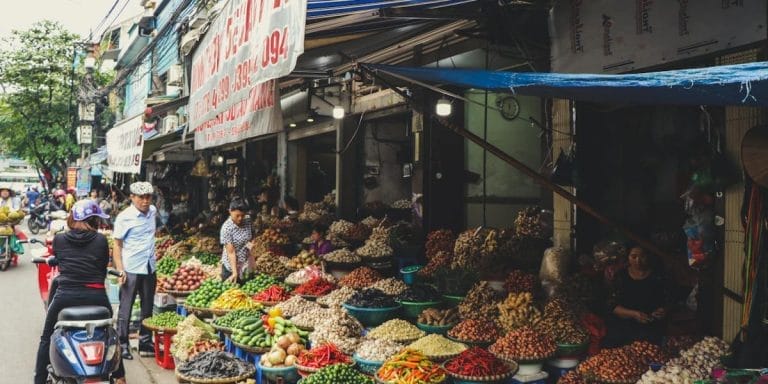Exploring the Enchanting World of Asian Markets and Bazaars
Imagine stepping into a bustling maze of vibrant colors, intoxicating aromas, and the symphony of eager vendors calling out their wares. This is the enchanting world of local markets and bazaars in Asia, where centuries-old traditions collide with modern-day commerce. Whether you’re a seasoned traveler or embarking on your first adventure to this captivating continent, exploring these bustling hubs of culture and commerce is an absolute must. From the bustling streets of Bangkok’s Chatuchak Market to the labyrinthine lanes of Istanbul’s Grand Bazaar, these vibrant marketplaces offer a sensory overload like no other. So, get ready to immerse yourself in the rich tapestry of Asian markets as we embark on a journey to uncover their hidden treasures, unique customs, and the stories that lie behind every stall.

Local Markets and Bazaars: A Cultural Exploration
Local markets and bazaars are vibrant hubs of commerce and cultural exchange found in various parts of the world. These bustling marketplaces offer a glimpse into the daily lives and traditions of the local communities, showcasing a diverse range of products, from fresh produce and handicrafts to clothing and spices.
Asia, in particular, is renowned for its rich tapestry of markets that have been an integral part of the region’s history for centuries. From the bustling street markets of Bangkok, Thailand to the floating markets of Vietnam’s Mekong Delta, each market offers a unique experience that reflects the local culture and way of life.
One of the most famous markets in Asia is the Chatuchak Weekend Market in Bangkok. Spanning over 35 acres, this sprawling market is a shopaholic’s paradise. With thousands of stalls selling everything from clothing and accessories to home decor and antiques, it attracts both locals and tourists alike. The market is divided into different sections, making it easier for visitors to navigate through the maze of shops.
In India, the bazaars are an integral part of the country’s cultural fabric. The Chandni Chowk in Old Delhi is one such iconic market that dates back to the 17th century. Known for its narrow lanes and chaotic atmosphere, this market is a treasure trove of traditional Indian goods. From intricate jewelry and textiles to aromatic spices and street food, Chandni Chowk offers a sensory overload that immerses visitors in the vibrant colors and flavors of India.
Another noteworthy market in Asia is the Grand Bazaar in Istanbul, Turkey. With a history dating back to the 15th century, this sprawling market is one of the oldest and largest covered markets in the world. It features over 4,000 shops selling a wide array of goods, including textiles, ceramics, carpets, and spices. The Grand Bazaar is not only a shopping destination but also a cultural landmark that reflects the city’s rich history and influences from various civilizations.
Local markets and bazaars are not just about shopping; they are also social and cultural spaces where people gather, interact, and celebrate their traditions. These markets often host festivals, performances, and food stalls, creating a lively atmosphere that brings communities together.
Whether you are a seasoned traveler or a curious explorer, visiting local markets and bazaars is an excellent way to immerse yourself in the local culture, witness the daily lives of the people, and discover unique treasures that can’t be found elsewhere. So, next time you find yourself in a new city or country, don’t miss the opportunity to explore the vibrant tapestry of a local market or bazaar.

Local markets and bazaars offer a plethora of sights, sounds, and smells that captivate the senses. As you wander through the narrow lanes of Chandni Chowk in Old Delhi, the vibrant colors of traditional textiles and intricate jewelry catch your eye. The aroma of aromatic spices wafts through the air, tempting you to sample the delicious street food. It’s a sensory overload that transports you to the heart of India’s cultural heritage.
In Istanbul’s Grand Bazaar, you find yourself immersed in a rich tapestry of history and craftsmanship. As you stroll through the labyrinthine corridors, you discover exquisite textiles, hand-painted ceramics, and intricately woven carpets. The market’s bustling atmosphere and diverse offerings reflect the city’s cosmopolitan past and the influences of various civilizations.
But it’s not just about shopping. Local markets and bazaars are social and cultural spaces that bring communities together. In Bangkok’s Chatuchak Weekend Market, you witness the vibrant energy as locals and tourists browse through thousands of stalls. The market becomes a melting pot of cultures, where people interact, celebrate, and share their traditions.
These markets also offer unique experiences that can’t be found elsewhere. In Vietnam’s Mekong Delta, you embark on a boat and navigate through the floating markets. As vendors sell their fresh produce and goods from their boats, you witness a way of life that is deeply connected to the region’s waterways. It’s a captivating glimpse into the daily lives of the locals.
Visiting local markets and bazaars is not just for seasoned travelers; it’s an opportunity for curious explorers to delve into the heart of a community. It’s a chance to witness the daily rhythms of life, discover hidden treasures, and engage with the local culture. So, the next time you find yourself in a new city or country, make sure to explore the vibrant tapestry of a local market or bazaar.

Exploring a local market or bazaar can be a truly immersive experience that allows you to delve deeper into the heart and soul of a place. The bustling atmosphere, the colorful array of products, and the lively interactions with locals can provide a unique insight into the local culture. From sampling exotic street food to haggling for handmade crafts, every moment spent in a market or bazaar can be a sensory adventure. The sights, sounds, and smells all come together to create a vibrant tapestry that showcases the essence of a destination. So, whether you’re in search of authentic souvenirs or simply want to soak up the local ambiance, make sure to include a visit to a market or bazaar in your travel itinerary.

Case Study 1: Grand Bazaar, Istanbul
The Grand Bazaar in Istanbul, Turkey, is one of the oldest and largest covered markets in the world. With over 4,000 shops spread across 61 streets, it offers a vibrant and bustling shopping experience. Visitors can find a wide range of goods, including textiles, jewelry, spices, ceramics, and carpets. The market has a rich history dating back to the 15th century and continues to be a major attraction for both locals and tourists.
Case Study 2: Tsukiji Fish Market, Tokyo
Tsukiji Fish Market in Tokyo, Japan, is the largest wholesale fish and seafood market in the world. It is famous for its early morning tuna auctions, where buyers bid on freshly caught fish. The market also offers a variety of seafood products, including sushi-grade fish, shellfish, and dried seafood. It attracts both professional chefs and tourists who want to experience the vibrant atmosphere and taste the freshest seafood.
Case Study 3: Camden Market, London
Camden Market in London, England, is a collection of markets located in the vibrant Camden Town neighborhood. It is known for its alternative fashion, vintage clothing, and unique crafts. The market offers a diverse range of products, from handmade jewelry and artwork to street food from around the world. Camden Market has become a cultural hub, attracting young and creative individuals who are looking for something different.
Case Study 4: Chatuchak Weekend Market, Bangkok
Chatuchak Weekend Market in Bangkok, Thailand, is one of the largest markets in Southeast Asia. It covers an area of 35 acres and features over 15,000 stalls. The market offers a wide array of products, including clothing, accessories, home decor, and antiques. It is a popular destination for both locals and tourists, who enjoy exploring the maze-like alleys and finding unique bargains.
Understanding the Cases
These case studies highlight the significance of local markets and bazaars in different parts of the world. Whether it’s the historical charm of the Grand Bazaar in Istanbul, the fresh seafood experience at Tsukiji Fish Market in Tokyo, the alternative fashion scene at Camden Market in London, or the vast variety of products at Chatuchak Weekend Market in Bangkok, these markets offer a glimpse into the local culture and provide an immersive shopping experience.
Local markets and bazaars are becoming increasingly popular among travelers seeking authentic experiences. In the future, these markets will continue to thrive as more tourists prioritize connecting with local cultures and traditions. Travelers can expect to find unique handicrafts, traditional foods, and cultural performances in these markets.
Local markets and bazaars will embrace technology to enhance the overall experience for travelers. From mobile apps providing market maps and vendor information to cashless payment options, technology will simplify the process of exploring and shopping in these markets. Travelers can expect a seamless blend of traditional charm and modern convenience.
In the future, local markets and bazaars will place a greater emphasis on sustainability. Travelers will witness a shift towards eco-friendly practices, such as reducing plastic waste, promoting local and organic products, and supporting fair trade. These markets will serve as platforms for promoting sustainable tourism and responsible consumption.
Local markets and bazaars will continue to be hubs for cultural exchange. As globalization progresses, these markets will adapt by incorporating elements from different cultures, resulting in unique fusion products and experiences. Travelers can expect to find a diverse range of goods and flavors, reflecting the blending of traditions from various regions.
While physical local markets and bazaars will remain essential, the future will also see the emergence of digital marketplaces and virtual experiences. Travelers will have the opportunity to explore and purchase local products online, providing convenience for those unable to visit in person. Virtual tours and immersive experiences will also allow travelers to get a taste of the vibrant atmosphere before planning their visit.

Local markets and bazaars are a must-visit for travelers seeking authentic experiences. These vibrant hubs offer unique handicrafts, traditional foods, and cultural performances, allowing tourists to connect with local cultures and traditions. In the future, these markets will thrive as more tourists prioritize these connections.
To enhance the overall experience, technology will play a role in local markets and bazaars. Mobile apps will provide market maps and vendor information, while cashless payment options will simplify the process of exploring and shopping. Travelers can expect a seamless blend of traditional charm and modern convenience.
Sustainability will be a key focus in the future of local markets and bazaars. These markets will reduce plastic waste, promote local and organic products, and support fair trade. They will become platforms for promoting sustainable tourism and responsible consumption.
Cultural exchange will continue to thrive in these markets. As globalization progresses, they will incorporate elements from different cultures, resulting in unique fusion products and experiences. Travelers can expect a diverse range of goods and flavors, reflecting the blending of traditions from various regions.
While physical markets will remain essential, the future will also see the emergence of digital marketplaces and virtual experiences. Travelers will have the opportunity to explore and purchase local products online, providing convenience for those unable to visit in person. Virtual tours and immersive experiences will allow travelers to get a taste of the vibrant atmosphere before planning their visit.







